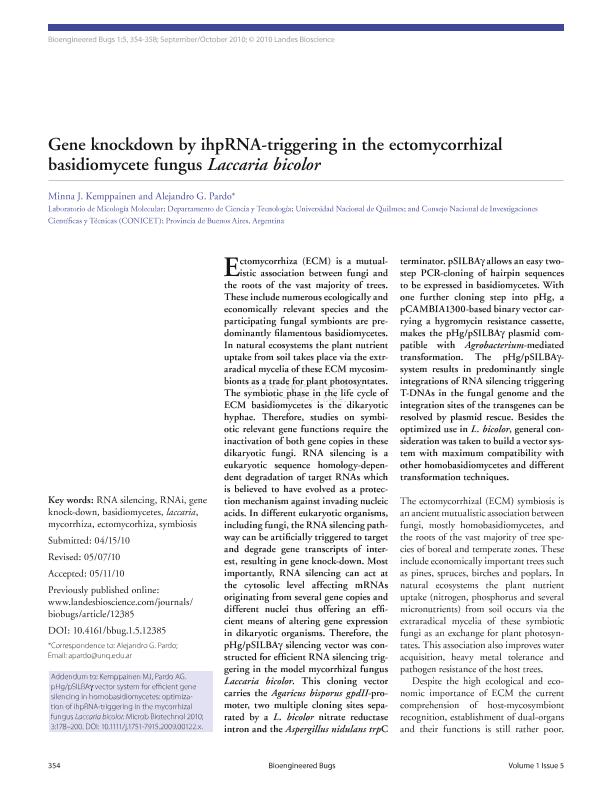Mostrar el registro sencillo del ítem
dc.contributor.author
Kemppainen, Minna Johanna

dc.contributor.author
Pardo, Alejandro Guillermo

dc.date.available
2023-03-20T15:00:28Z
dc.date.issued
2010-09
dc.identifier.citation
Kemppainen, Minna Johanna; Pardo, Alejandro Guillermo; Gene knockdown by ihpRNA-triggering in the ectomycorrhizal basidiomycete fungus Laccaria bicolor; Taylor & Francis; Bioengineered Bugs; 1; 5; 9-2010; 354-358
dc.identifier.issn
1949-1018
dc.identifier.uri
http://hdl.handle.net/11336/191010
dc.description.abstract
Ectomycorrhiza (ECM) is a mutualistic association between fungi and the roots of the vast majority of trees. These include numerous ecologically and economically relevant species and the participating fungal symbionts are predominantly filamentous basidiomycetes. In natural ecosystems the plant nutrient uptake from soil takes place via the extraradical mycelia of these ECM mycosimbionts as a trade for plant photosyntates. The symbiotic phase in the life cycle of ECM basidiomycetes is the dikaryotic hyphae. Therefore, studies on symbiotic relevant gene functions require the inactivation of both gene copies in these dikaryotic fungi. RNA silencing is a eukaryotic sequence homology-dependent degradation of target RNAs which is believed to have evolved as a protection mechanism against invading nucleic acids. In different eukaryotic organisms, including fungi, the RNA silencing pathway can be artificially triggered to target and degrade gene transcripts of interest, resulting in gene knock-down. Most importantly, RNA silencing can act at the cytosolic level affecting mRNAs originating from several gene copies and different nuclei thus offering an efficient means of altering gene expression in dikaryotic organisms. Therefore, the pHg/pSILBAγ silencing vector was constructed for efficient RNA silencing triggering in the model mycorrhizal fungus Laccaria bicolor. This cloning vector carries the Agaricus bisporus gpdII-promoter, two multiple cloning sites separated by a L. bicolor nitrate reductase intron and the Aspergillus nidulans trpC terminator. pSILBAγ allows an easy twostep PCR-cloning of hairpin sequences to be expressed in basidiomycetes. With one further cloning step into pHg, a pCAMBIA1300-based binary vector carrying a hygromycin resistance cassette, makes the pHg/pSILBAγ plasmid compatible with Agrobacterium-mediated transformation. The pHg/pSILBAγ- system results in predominantly single integrations of RNA silencing triggering -DNAs in the fungal genome and the ntegration sites of the transgenes can be esolved by plasmid rescue. Besides the ptimized use in L. bicolor, general considerationwas taken to build a vector system with maximum compatibility with other homobasidiomycetes and different transformation techniques.
dc.format
application/pdf
dc.language.iso
eng
dc.publisher
Taylor & Francis

dc.rights
info:eu-repo/semantics/openAccess
dc.rights.uri
https://creativecommons.org/licenses/by-nc-sa/2.5/ar/
dc.subject
BASIDIOMYCETES
dc.subject
ECTOMYCORHIZA
dc.subject
GENE KNOCK-DOWN
dc.subject
LACCARIA
dc.subject
MYCORRHIZA
dc.subject
RNA SILENCING
dc.subject
RNAI
dc.subject
SYMBIOSISS
dc.subject.classification
Micología

dc.subject.classification
Ciencias Biológicas

dc.subject.classification
CIENCIAS NATURALES Y EXACTAS

dc.title
Gene knockdown by ihpRNA-triggering in the ectomycorrhizal basidiomycete fungus Laccaria bicolor
dc.type
info:eu-repo/semantics/article
dc.type
info:ar-repo/semantics/artículo
dc.type
info:eu-repo/semantics/publishedVersion
dc.date.updated
2023-03-15T10:13:32Z
dc.journal.volume
1
dc.journal.number
5
dc.journal.pagination
354-358
dc.journal.pais
Reino Unido

dc.description.fil
Fil: Kemppainen, Minna Johanna. Consejo Nacional de Investigaciones Científicas y Técnicas; Argentina. Universidad Nacional de Quilmes. Departamento de Ciencia y Tecnología. Laboratorio de Micología Molecular; Argentina
dc.description.fil
Fil: Pardo, Alejandro Guillermo. Consejo Nacional de Investigaciones Científicas y Técnicas; Argentina. Universidad Nacional de Quilmes. Departamento de Ciencia y Tecnología. Laboratorio de Micología Molecular; Argentina
dc.journal.title
Bioengineered Bugs
dc.relation.alternativeid
info:eu-repo/semantics/altIdentifier/url/https://www.tandfonline.com/doi/full/10.4161/bbug.1.5.12385
dc.relation.alternativeid
info:eu-repo/semantics/altIdentifier/doi/http://dx.doi.org/10.4161/bbug.1.5.12385
Archivos asociados
